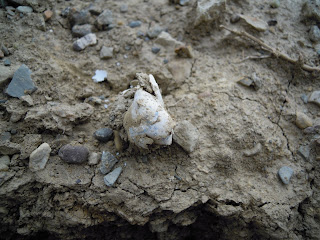I've been up to more dyeing. The other day, I gathered more marigolds from the garden along with some wild goldenrod, and threw the flowers into the dye pot along with some onion skins and some marjoram from the herb garden. All of these things make yellow. Here's the hodgepodge in the dye pot:
It dyed my superwash BFL roving a nice goldish-yellow.
Yesterday, my daughter and I went on a little adventure to gather more dyestuff. I've been dying (ha!) to get out to a place I know where a ton of cleavers grows. Cleavers is related to madder, and like madder, cleavers roots will make a red dye.
So, off we went, bushwhacking our way through waist-high brush and brambles. The dog was smarter and took off on his own. We learned that he found the deer trail right away that we had been hoping to run across. Next time we'll follow the dog.
While crossing the railroad tracks, my daughter spotted some sort of buried egg nest that had been dug up by a coyote (we found dung nearby). The round, leathery eggs had been eaten. We guess they were tortoise or snake - anyone out there care to take a guess? Some of the eggs seemed to have bluish speckles, but that may have been something other than speckles.
Here's the dug-up nest:
A close-up of one of the egg remains:
Anyhoo, we did eventually reach the cleavers. Digging cleavers is hard going. It's hard to find a clump of cleavers that will yield a substantial root. And interspersed amongst the cleavers was poison ivy. We tried to be careful, and we washed with Tecnu poison ivy scrub when we got home, but I woke up with poison ivy on my forearms this morning. Good thing I make the best ever poison ivy itch relief spray.
When we got back home, I sprayed the dirt off of the roots with the garden hose outside. Here's a nice root:
And here's our clump of roots, all washed and ready for soaking. You can see how they're reddish in color:
We gathered about 4 ounces. I was hoping to get at least 8 ounces, but we decided to cut the gathering short when we began to feel raindrops. I'm hoping the 4 ounces of roots will dye at least two ounces of wool.
Our gathering wasn't done for the day, however. My daughter knew where we could gather a good amount of pokeberries. I've recently read about a method to make a really nice reddish dye using these berries (which are poisonous, so no eating!) using vinegar as a mordant. I've been wanting to try it, so off we went to gather pokeberries before the sun set.
We gathered about two pounds of berries. Amazingly, this will only dye about one ounce of wool. The ratio of dyestuff to wool for pokeberries using this method is high - 25:1. Here's a peek into one of our bags of berries:
Today I'll be busy dyeing.
We also found a patch of blooming tickseed flowers on our wanderings. Tickseed flowers are yellow, but make a pretty, orange dye. We may go back for those. Not sure yet. I'll be busy enough today as it is.















4 comments:
gosh you have a lot of patience!
xxx
Hi Lyn!
I wasn't born with patience. I think I learned it when I took up baking bread : )
Sorry to hear about your brush with poison ivy. The results of your dyeing are gorgeous, though. Also, thanks for the link to the book by Rebecca Burgess. Being able to keep that color vibrant is great.
Hi Diane!
The poison ivy is almost all gone now - although I still wake up in the middle of the night itching.
And I sure hope I followed the pokeberry dyeing instructions properly - the color is amazing and it'd be a shame for it to fade away.
Post a Comment